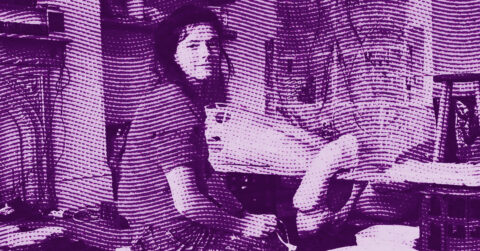Listen to me carefully, you bunch of snobs: there is something authentic happening in Zhang Nan’s studio, and it deserves rigorous critical attention that we owe to artists who reject easy solutions. This young Chinese painter, a graduate of ENSAD Nancy in June 2025 and who can be discovered this week at Luxembourg Art Week 2025 thanks to the Institut Français du Luxembourg and the Victor Hugo Association, offers with her series Brothers a pictorial meditation on violence and the absurd that far exceeds a simple academic exercise.
When Zhang Nan states that she reread Au bord de l’eau before conceiving this series, she does not mean a superficial inspiration but a true confrontation with one of the foundational texts of the Chinese imagination. This fourteenth-century classic novel, attributed to Shi Nai’an, recounts the adventures of one hundred and eight bandits gathered around a marsh to challenge a corrupt empire [1]. But Zhang Nan does not seek to illustrate the story. She extracts what she herself calls “a certain intensity, a raw violence, often unconscious,” deliberately rejecting historical markers to reach something more essential. This aesthetic decision is not trivial: it places her work in a genealogy that prioritizes the expression of the human condition over documentary reconstruction.
What immediately strikes in her series Brothers is the artist’s ability to maintain a precarious balance between narration and abstraction. The large format canvases, oil on canvas measuring 160 x 120 centimeters, evoke scenes of murder and cruelty drawn from the classic novel, but Zhang Nan systematically refuses the spectacular. “I deliberately avoided bloody images, for example by changing the color of the blood,” she explains. This strategy of chromatic diversion is not misplaced modesty but a categorical refusal of complacency in horror. The artist does not want the viewer to be “distracted by a direct visual shock,” because what interests her is not violence as such, but what it reveals about human absurdity.
It is precisely here that her connection to Max Beckmann takes full meaning. The German artist, exiled in Amsterdam and then in the United States, devoted the last years of his life to painting monumental triptychs that combined personal allegory and commentary on the human condition in a century torn by wars. Works such as Departure (1933-1935), The Actors (1941-1942), or The Carnival (1942-1943) testify to an obsession with representing humanity compressed within claustrophobic spaces, where violence coexists with a form of tragic dignity [2]. Beckmann wrote in 1918: “I try to capture the terrible monster throbbing with the vitality of life and to confine it, subdue it, and strangle it with crystalline lines and razor-sharp planes” [3]. This tension between capturing vital energy and its rigorous shaping resonates deeply with Zhang Nan’s project.
But be careful: this is not a simple pastiche. Whereas Beckmann deployed his compositions in triptychs, playing on formal and symbolic echoes between the side panels and the central panel, Zhang Nan deliberately chooses to fragment the narrative into autonomous canvases that refuse any fixed order. “This series has no fixed order,” she insists, “the numbers in the titles correspond only to the order of creation.” This decision to reject narrative hierarchy places the viewer in an uncomfortable position: faced with these scenes of violence without specific context or identifiable historical markers, we are forced to seek meaning elsewhere than in the chronological sequence of events.
The figures painted by Zhang Nan are bodies in crisis, deformed anatomies that bear the trace of rigorous academic training, she completed her initial training at the Xi’an Academy of Fine Arts, but have undergone a process of radical deconstruction. “I even thought about abandoning art studies,” she confides. This period of doubt produced a fruitful rupture: rather than reproducing actual anatomy, Zhang Nan reconstructs “another form of structure through painting, a structure not based on external appearance, but on interiority.” The bodies she paints are therefore not errors or approximations, but intentional constructions seeking to make visible what ordinarily remains hidden.
The reference to Francis Bacon, which she herself mentions in her artist’s statement, is not accidental. Like the Irish painter, Zhang Nan seeks to “capture a new form of reality in an era marked by the domination of photographic imagery.” But again, one must be wary of too rapid assimilations. While Bacon was interested in deformation as a means to reveal the truth of flesh, Zhang Nan works deformation as a tool of depersonalization. By deliberately erasing “certain markers such as age, origin, or sometimes even gender,” she creates figures that aspire to a form of universality. Paradoxically, it is by stripping them of their individual attributes that she makes them capable of “resonating with a diversity of gazes and personal histories.”
This ambition of universality might seem naive or pretentious if it were not supported by an acute awareness of her own limits and contradictions. Zhang Nan does not claim to have found a definitive formula; she explores, experiments, and builds her visual language through the canvases. The Brothers series remains unfinished, in perpetual expansion, which testifies to remarkable artistic maturity for a freshly graduated artist. She understands that some questions cannot be solved, only reformulated with increasing precision.
The choice to settle in Berlin after her studies at ENSAD Nancy also deserves attention. This city, with its troubled history and current position as a European artistic crossroads, offers a particularly favorable context for an artist working on memory, violence, and identity. Far from being a mere practical decision, this geographical choice fits a coherent logic: Zhang Nan deliberately positions herself in a cultural space that values experimentation and critical dialogue. “I feel more affinity with the European artistic context,” she explains, “richer, more diverse, and more favorable to experimentation and dialogue.”
There is something deeply honest in Zhang Nan’s approach. She does not claim to resolve the tensions she explores; she exposes them with a frankness that can sometimes be unsettling. Her paintings are not comfortable. They do not offer easy catharsis or satisfying narrative resolution. They confront us with a vision of humanity in which loyalty and brotherhood, these values superficially celebrated by Au bord de l’eau, coexist with primordial violence and congenital absurdity. It is precisely this ambivalence that gives strength to her work.
One might criticize Zhang Nan for a certain heaviness in her treatment of subjects, a tendency to emphasis that sometimes weighs down the composition. Some canvases from the Brothers series seem to hesitate between the desire for formal clarity and the temptation of expressionist pathos. But these imbalances are part of the process. This artist is not at the end of her path; she is building something, canvas after canvas, mistake after mistake, and that is precisely what makes her work exciting to follow.
What makes Zhang Nan unique in the contemporary art scene is her ability to articulate several heritages without hierarchizing or artificially opposing them. She draws from classical Chinese literature as naturally as she refers to German expressionism, and this dual belonging is never experienced as a contradiction. On the contrary, it is precisely in this in-between, in this zone of productive friction between traditions, that her work finds its most authentic voice.
When observing the hanging she proposed at her graduation, three canvases from the Brothers series arranged side by side, one immediately understands her mastery of exhibition space. The paintings dialogue without explaining each other, creating a formal and chromatic tension that amplifies the impact of each individual work. This intelligence of spatial arrangement, this intuitive understanding of how paintings interact with each other, is a sign of an artist who thinks her work beyond the mere pictorial gesture.
Zhang Nan belongs to that generation of artists who refuse the ease of explicit social commentary without retreating into pure abstraction. She maintains a link with figuration, but a figuration constantly challenged, questioned, destabilized. Her characters are neither heroes nor victims; they are ambiguous presences that carry within them all the complexity and absurdity of the human condition.
It would be premature to predict where this research will lead her. But one thing is certain: with the Brothers series, Zhang Nan has laid the foundations of a pictorial language worthy of close attention. Her work does not revolutionize figurative painting, nor is that her ambition, but it brings a singular voice, a perspective that enriches our understanding of what painting can be today. In a world saturated with images, Zhang Nan reminds us that oil painting, this ancestral technology, still has unexplored resources to confront us with what constitutes and disturbs us.
Facing her paintings, one does not come out unscathed. One does not leave comforted. But one leaves with questions, and that is precisely what one has the right to expect from art that refuses compromises. Zhang Nan does not offer us answers. She hands us a distorted mirror in which we can, if we accept to look truly, glimpse something of our own violence, our own absurdity, our own humanity. That is already much. It may even be essential.
- Shi Nai’an, Outlaws of the Marsh, translation Jacques Dars, Gallimard, collection La Pléiade, 1978
- Stephan Lackner, Max Beckmann 1884-1950 The Nine Triptychs, Safari-Verlag, Berlin, 1965
- Max Beckmann, “A Confession”, 1918, cited in Carla Hoffmann-Schulz and Judith C. Weitz, Max Beckmann: Retrospective, St. Louis Art Museum and Prestel-Verlag, 1984
















